 |
| A drug-like inhibitor that stops Listeria from making virulence proteins helps immune cells control and kill the bacteria. Image: Dr Carmen Mathmann |
University of Queensland researchers have unlocked a way of fighting Listeria infections, which can cause severe illness in pregnant women and people with compromised immune systems.
During the study, researchers discovered a way to block Listeria from making the proteins that allow bacteria to survive and multiply in immune cells.
UQ Diamantina Institute’s Professor Antje Blumenthal said using a small, drug-like inhibitor has improved their understanding of the Achilles heel of Listeria.
“Listeria is found in the soil and sometimes in raw foods. Once ingested it can hide from the immune system and multiply inside immune cells,” Professor Blumenthal said.
“Instead of killing the bacteria, the immune cells are used by the bacteria to multiply and are often killed by Listeria growing inside them.
“Our study showed the bacteria could be cleared with a small drug-like inhibitor that targets the 'master regulator’ of the proteins that help Listeria grow in immune cells. The inhibitor helped the immune cells survive infection and kill the bacteria.”











.jpg)



.jpg)

